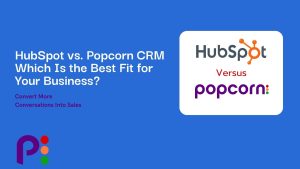Effective Tactics to Get Hold of the Decision Maker
In today’s fast-paced business world, connecting with decision-makers is more crucial than ever. However, gaining their attention amidst a sea of competing priorities poses a significant challenge. Whether you’re pitching a product, seeking a partnership, or proposing a service, the ability to directly engage with those at the helm can make or break your efforts.
In this blog, you will learn:
– Strategies for identifying and reaching decision-makers directly.
– How to leverage social media and professional networks effectively.
– Techniques for crafting compelling messages that demand attention.
Armed with the right tactics, you can cut through the noise and position your proposal front and centre. Let’s dive into how you can enhance your approach and ensure your message reaches the top.
—
Using Popcorn to Effectively Target Decision Makers
In the complex journey of reaching and engaging decision-makers, Popcorn CRM emerges as a powerful ally. Our Customer Relationship Management tool is designed to streamline your outreach and follow-up processes, ensuring that no opportunity slips through the cracks. Here’s how Popcorn CRM can transform your approach:
Centralised Information Storage: Popcorn CRM allows you to keep detailed records of each decision-maker, including their contact information, communication history, and personal preferences. This centralised data repository ensures you can personalise your outreach and follow-up efforts effectively.
Activity Tracking and Notifications: Stay on top of your interactions with decision-makers. Popcorn CRM provides real-time notifications and reminders for follow-ups, ensuring you never miss an opportunity to engage at the right time.
Segmentation for Targeted Communication: With Popcorn CRM, you can segment decision-makers based on industry, company size, or their position in the buying journey. This segmentation enables you to tailor your messaging, increasing its relevance and impact.
Analytical Insights: Understanding what works and what doesn’t is crucial for refining your strategy. Popcorn CRM offers analytics on your outreach efforts, showing which messages resonate and lead to engagement. Use these insights to adjust your approach and improve your success rate.
Automated Workflows: Save time and increase efficiency with automated workflows. From sending initial outreach emails to scheduling follow-ups based on engagement, Popcorn CRM automates repetitive tasks, letting you focus on crafting compelling messages and strategies.
By integrating Popcorn CRM into your decision-maker targeting approach, you can enhance your efficiency, personalise your outreach, and ultimately, improve your success rate in connecting with key decision-makers. Popcorn CRM is not just a database but a strategic partner in your quest to win over the decision-makers critical to your business success.
Conclusion
Successfully reaching and engaging decision-makers is both an art and a science. It requires a deep understanding of the decision-making landscape, a strategic approach to identification and outreach, and the ability to leverage social media and professional networks effectively.
The tactics we’ve explored—ranging from personalised communication and leveraging LinkedIn, to strategic follow-ups and learning from real-world success stories—underscore the importance of a targeted and thoughtful approach.
In this article, we’ve uncovered:
– The significance of identifying the right decision-makers within an organisation.
– The power of personalised and value-driven communication.
– The strategic use of social media and professional networks to build connections.
– How leveraging popcorn CRM, you can automate and streamline your decision-maker connection strategy.
As you implement these strategies, remember that persistence, personalisation, and providing clear value are your greatest tools in navigating the complex landscape of decision-making in any organisation.
By applying these tactics and continuing to refine your approach based on feedback and outcomes, you’ll enhance your ability to connect with decision-makers and achieve your business objectives.
Understanding the Decision-Maker Landscape

In any organisation, decisions are rarely made in isolation. From small businesses to global conglomerates, the decision-making process typically involves multiple stakeholders, each with their unique priorities and concerns. Understanding this landscape is the first step toward successfully engaging with decision-makers.
Decision-makers can range from CEOs and department heads to project managers and procurement officers, depending on the organisation’s size and the nature of your proposal. Their primary focus is to make choices that align with the company’s strategic goals and deliver tangible benefits. Therefore, your approach must resonate not just with their business objectives but also address how it can help them achieve their success metrics.
Key Components of the Decision-Making Process:
- Identifying Needs: Decision-makers are constantly on the lookout for solutions that address their current challenges or opportunities. Demonstrating an understanding of their needs is crucial.
- Evaluating Options: They weigh the pros and cons of various solutions, considering factors like cost, ROI, implementation time, and potential risks.
- Seeking Recommendations: Endorsements from trusted sources within or outside the organisation can significantly influence their decision.
- Making the Decision: The final choice involves not only logical analysis but also intuition and personal bias toward certain solutions or providers.
To engage effectively with decision-makers, your outreach should demonstrate a clear understanding of these components. It should articulate how your offering aligns with their needs, stands out among alternatives, and has garnered positive reviews or endorsements.
In the following sections, we’ll explore strategies for identifying these key individuals and crafting messages that resonate with their priorities and decision-making processes.
Strategies for Identifying Decision Makers
Identifying the right decision-makers within an organisation is a critical first step in your outreach strategy. Here’s how to pinpoint these key individuals:
Leverage Professional Networks: LinkedIn is a goldmine for identifying potential decision-makers. Use the search function to find employees within your target companies and analyse their titles and roles. LinkedIn’s “People Also Viewed” section can also reveal other relevant contacts within the organisation.
Utilise Company Websites: Many companies list their leadership team and key department heads on their websites. Review these sections to understand the hierarchy and identify who might be the best person to approach based on your offering.
Attend Industry Events: Conferences, webinars, and networking events are excellent opportunities to learn about companies and meet decision-makers in person. Even virtual events can provide valuable insights and networking opportunities.
Use Press Releases and News Articles: Companies often announce major decisions, partnerships, and projects through press releases and news articles. These can give you clues about who is in charge of various initiatives.
Ask for Introductions: If you have a mutual connection, don’t hesitate to ask for an introduction. A warm lead can be much more effective than a cold outreach.
Crafting Your Approach
Once you’ve identified the decision-makers, the next step is to craft a message that captures their attention:
Personalise Your Communication: Show that you’ve done your homework by personalising your message with details about their company and role. Avoid generic pitches.
Highlight Benefits, Not Features: Focus on how your product or service can solve their problems or enhance their business, rather than just listing features.
Use Social Proof: Mention any mutual connections, shared experiences, or relevant case studies to build credibility.
Be Concise and to the Point: Decision-makers are busy. Make your value proposition clear and concise, and avoid burying it under unnecessary details.
Follow Up Strategically: If you don’t hear back, follow up with additional information that adds value, such as a relevant article or a case study highlighting your success with a similar company.
By combining targeted research with personalised, value-focused messaging, you can increase your chances of not just reaching decision-makers but also engaging them effectively.
Leveraging Social Media and Professional Networks

Social media and professional networks, especially LinkedIn, are invaluable tools for connecting with decision-makers. Here’s how to use these platforms effectively:
Engage Authentically: Instead of immediately pitching your product or service, engage with potential decision-makers by commenting on their posts, sharing relevant content, and participating in industry-specific discussions. This helps build recognition and trust.
Share Insightful Content: Position yourself as an industry thought leader by sharing insightful articles, case studies, and content that addresses common challenges faced by your target decision-makers. This approach not only demonstrates your expertise but also how your services or products provide solutions.
Direct Messaging: Once you’ve established a connection through engagement, consider reaching out with a personalised message. Highlight mutual interests or connections and succinctly introduce how you might help address their needs or challenges.
Utilise Advanced Search Features: LinkedIn’s advanced search allows you to filter professionals by industry, company, position, and more, making it easier to identify and connect with the right decision-makers.
Join Relevant Groups: Participate in LinkedIn groups where your target decision-makers are likely to be members. Engaging in these groups can increase your visibility and opportunities for direct engagement.
Following Up Without Being Annoying
Persistence is key in outreach, but it’s important to follow up without being intrusive:
Space Your Communications: Allow sufficient time between your follow-ups. Waiting a week or two between messages is generally a good practice.
Add Value with Each Interaction: Each time you reach out, provide new information or value. Share a relevant article, offer an insight, or mention a recent development in their industry that might impact their business.
Be Mindful of Signals: Pay attention to their responses or lack thereof. If someone explicitly asks not to be contacted again, respect their wishes.
Utilise Multiple Channels: If email isn’t working, try reaching out on social media, or vice versa. Sometimes, a change in the medium can make your message more noticeable.
Know When to Pause: If you’ve followed up several times without any response, it may be time to pause and revisit that prospect later. They might not have a current need for your offering, but circumstances can change.
By strategically leveraging social media and professional networks, and following up thoughtfully, you can significantly improve your chances of getting your message in front of the right decision-makers.
Using Popcorn to Effectively Target Decision Makers

In the complex journey of reaching and engaging decision-makers, Popcorn CRM emerges as a powerful ally. Our Customer Relationship Management tool is designed to streamline your outreach and follow-up processes, ensuring that no opportunity slips through the cracks. Here’s how Popcorn CRM can transform your approach:
Centralised Information Storage: Popcorn CRM allows you to keep detailed records of each decision-maker, including their contact information, communication history, and personal preferences. This centralised data repository ensures you can personalise your outreach and follow-up efforts effectively.
Activity Tracking and Notifications: Stay on top of your interactions with decision-makers. Popcorn CRM provides real-time notifications and reminders for follow-ups, ensuring you never miss an opportunity to engage at the right time.
Segmentation for Targeted Communication: With Popcorn CRM, you can segment decision-makers based on industry, company size, or their position in the buying journey. This segmentation enables you to tailor your messaging, increasing its relevance and impact.
Analytical Insights: Understanding what works and what doesn’t is crucial for refining your strategy. Popcorn CRM offers analytics on your outreach efforts, showing which messages resonate and lead to engagement. Use these insights to adjust your approach and improve your success rate.
Automated Workflows: Save time and increase efficiency with automated workflows. From sending initial outreach emails to scheduling follow-ups based on engagement, Popcorn CRM automates repetitive tasks, letting you focus on crafting compelling messages and strategies.
By integrating Popcorn CRM into your decision-maker targeting approach, you can enhance your efficiency, personalise your outreach, and ultimately, improve your success rate in connecting with key decision-makers. Popcorn CRM is not just a database but a strategic partner in your quest to win over the decision-makers critical to your business success.
Conclusion
Successfully reaching and engaging decision-makers is both an art and a science. It requires a deep understanding of the decision-making landscape, a strategic approach to identification and outreach, and the ability to leverage social media and professional networks effectively.
The tactics we’ve explored—ranging from personalised communication and leveraging LinkedIn, to strategic follow-ups and learning from real-world success stories—underscore the importance of a targeted and thoughtful approach.
In this article, we’ve uncovered:
– The significance of identifying the right decision-makers within an organisation.
– The power of personalised and value-driven communication.
– The strategic use of social media and professional networks to build connections.
– How leveraging popcorn CRM, you can automate and streamline your decision-maker connection strategy.
As you implement these strategies, remember that persistence, personalisation, and providing clear value are your greatest tools in navigating the complex landscape of decision-making in any organisation.
By applying these tactics and continuing to refine your approach based on feedback and outcomes, you’ll enhance your ability to connect with decision-makers and achieve your business objectives.











